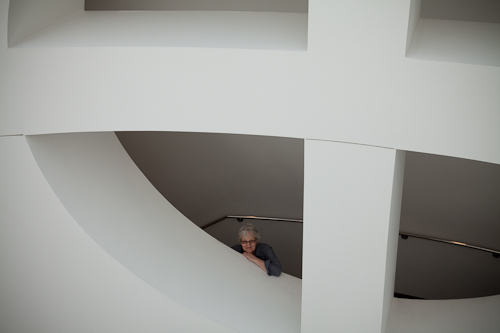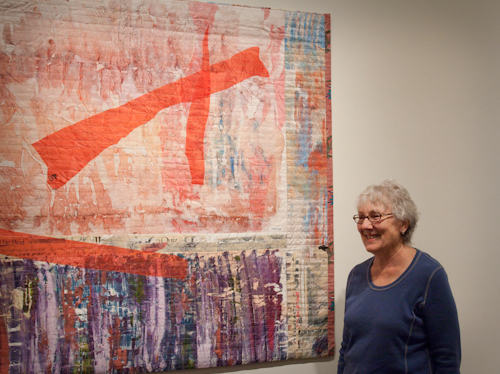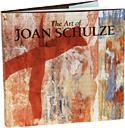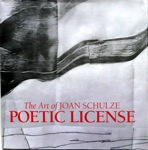Joan Schulze: Famous activist of art
 Joan at SFMOMA. Photo by Deidre Adams.
Joan at SFMOMA. Photo by Deidre Adams.
Last week, I had the great privilege to spend several days visiting my friend Joan Schulze. Joan is an internationally recognized artist known primarily for her quilts, but she also works extensively with paper, making collages and artists books, and she is an accomplished poet. Her work has just been featured in a 40-year retrospective called Poetic License: The Art of Joan Schulze, on view at the San Jose Museum of Quilts & Textiles through May 9.
 Joan Schulze with The Angel Equation, ©1994, 56 x 57 inches.
Joan Schulze with The Angel Equation, ©1994, 56 x 57 inches.
Silk, paper, cotton, and transparent overlays.
Photo by Deidre Adams.
Joan’s long and illustrious career in the arts began with embroidery in the early 1970s and quickly expanded to quilts. She has always been an innovator and was an early pioneer in using techniques that art quilters take for granted today. Over the course of the last 40 years, she has made over 1800 quilts and collages, exhibiting a phenomenal dedication and never-ending passion to her work that serves as a true inspiration to artists working in any medium. Her artwork and her poetry enjoy a symbiotic relationship, as each is nurtured by the other. As she says, “Writing poetry is as necessary as stitching cloth.”¹
Joan’s work is known around the world, and in addition to exhibiting and teaching in many countries, she has developed strong ties with artists and teachers in China through her affiliation with the Beijing International Tapestry Exhibitions and Tsinghua University. As she does not have an official academic title, the Chinese bestowed upon her their own title: “Famous Activist of Art.” They’ve since expanded it, but I think this one is succinct and says it best.
 My first introduction to Joan’s work came through a marvelously beautiful book which arrived at the offices of Quilter’s Newsletter Magazine one day while I was working there as a graphic artist. Titled The Art of Joan Schulze, it was an eye-opening experience for me, containing very large and detailed photographs of her work, along with essays and anecdotes by other artists, and a selection of Joan’s poems. At that time, I was beginning to understand how quilts could be art, but this book transcended anything I had encountered before.
My first introduction to Joan’s work came through a marvelously beautiful book which arrived at the offices of Quilter’s Newsletter Magazine one day while I was working there as a graphic artist. Titled The Art of Joan Schulze, it was an eye-opening experience for me, containing very large and detailed photographs of her work, along with essays and anecdotes by other artists, and a selection of Joan’s poems. At that time, I was beginning to understand how quilts could be art, but this book transcended anything I had encountered before.
In 2008, I was fortunate to be able to meet Joan in person when she and I and Teresa Barkley shared a hotel suite in Traverse City, Michigan, while we were all there for the opening of the 12 Voices exhibition. Joan and I found we enjoyed a lot of the same things: good food and wine, going to art galleries, taking pictures at the abandoned Traverse City State Hospital (a.k.a. the Northern Michigan Asylum), exploring the nearby roads and towns, shopping at second-hand stores, and admiring stones on the beach — whether on the shores of Lake Michigan or the Pacific coast, as on this recent trip. Knocking about with Joan is an educational experience, as she has a unique perspective and looks at everything in a careful, considered way, seeing what others miss.
I was so excited to have this opportunity to visit her in her own world. We did so much in just a few short days, it’s hard to know where to begin. It was complete art immersion, beginning with Joan’s beautiful house and her extensive art collection, then visits to museums and Joan’s studio in San Francisco, and topped off by a visit to her retrospective at the gallery. On Wednesday, Joan gave an artist’s talk for members of the SAQA Northern California-Nevada region. She talked about the stories and inspiration for each quilt in the exhibition, as well as reading correlated selections from her own poetry.
I won’t attempt to describe the exhibition, but if you’d like to know more, you can read a descriptive and thoughtful review by artist Liz Hager on the Venetian Red blog. Joan also speaks about her life in the arts in this article from the San Jose Mercury News. I also highly recommend a visit to her web site for many luscious images and more information.
 Poetic License: The Art of Joan Schulze is accompanied by another beautiful book (to call it a catalog would understate its presence) with photographs of quilts in the exhibition plus many more, and essays by Deborah Corsini, Sarah E. Tucker, and Peter Frank. It’s available on Joan’s web site.
Poetic License: The Art of Joan Schulze is accompanied by another beautiful book (to call it a catalog would understate its presence) with photographs of quilts in the exhibition plus many more, and essays by Deborah Corsini, Sarah E. Tucker, and Peter Frank. It’s available on Joan’s web site.

